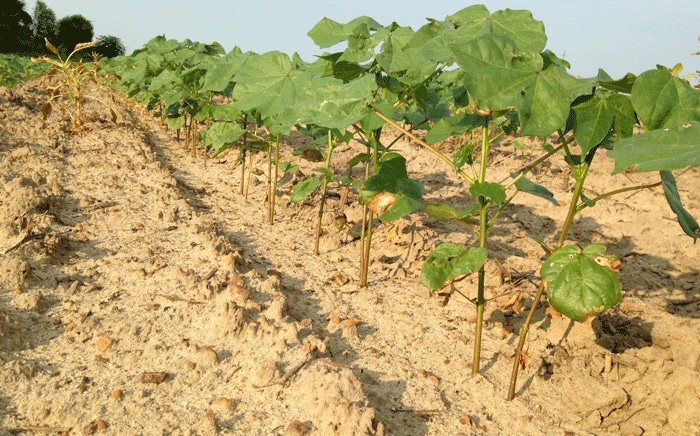
Tailgate Talk: Decisions now and products to know for better disease control
Seed companies continue to offer selections with improved resistance not only to diseases but to nematodes as well. There are at least four commercial cotton varieties currently available to growers with documented resistance to the root-knot nematode.
January 20, 2015

“No rest for the weary,” as the saying goes. Though months away from planting, a grower’s decisions now will profoundly influence the disease and nematode control he gets in 2015. Planning an effective crop rotation and ensuring access to effective products are timely actions important for the next field season.
For example, to optimize use of a nematicide like Telone II that may have restricted supply, growers should contact certified dealers to secure an adequate volume and also contact Dow representatives for assistance in calibration and maintenance of fumigation equipment. Now is the time for education on new products, both fungicides and nematicides, which are likely to be available in 2015.
(Editor’s note: Tailgate Talk is a series of articles by University of Georgia Extension specialists Eric Prostko and Bob Kemerait, covering weed and disease management strategies for peanut, corn, soybean and cotton production in 2015.)
Priaxor from BASF, a combination of pyraclostrobin (Headline) and fluxapyroxad, is labeled for use on multiple crops and it will be widely available next season. Elatus from Syngenta is a combination of Abound and solatenol and it should be labeled in time for use on peanuts. Though southern corn, soybean and wheat crops are not targeted for 2015, Syngenta wil relaease Trivapro (Quadris + solatenol + Tilt) into the market and our farmers will begin to hear about this new combination of fungicides.
Velum Total from Bayer CropScience, a pre-mix of fluopyram and imidacloprid for management of nematodes and thrips, is on track to for use on peanuts and cotton next season. Generic formulations of azoxystrobin, in addition to Azaka from Cheminova, may also be available. Growers can learn more about these and other products by contacting their local Extension agents, Industry representatives and chemical dealers as well as through trade publications and grower meetings.
The single most important decision that a grower needs to consider now is the variety of seed to be purchased. Seed companies continue to offer selections with improved resistance not only to diseases but to nematodes as well. Today, variety selection has significant impact on yield potential and losses to disease and nematodes. Use of resistant varieties should reduce the need for inputs of pesticides and provide significant yield protection where pest problems occur.
Diseases to watch for in 2015
Every corn grower in the southern United States should be aware of the level of resistance to northern corn leaf blight and Diplodia ear rot in the hybrids they consider planting. Northern corn leaf blight is likely to occur every year and is associated with significant yield loss. Though this disease can be managed to some degree with fungicides, the best management strategy is to plant a hybrid documented to have resistance.
Diplodia ear rot is most severe when cooler and wetter conditions occur during silking and pollinating growth stages. Though such conditions are atypical in the South, when they do occur, losses to Diplodia ear rot can be staggering and there is nothing at that point to be done for control of the disease. Planting a resistant variety is critical in such cases.
The southern root knot nematode (Meloidogyne incognita) is a major pest of cotton. There are at least four commercial varieties currently available to growers with documented resistance to the root-knot nematode. These include Phytogen 427WRF, Phytogen 367WRF, Delta and Pineland 1454B2RF and Stoneville 4946GLB2. Not only will these varieties be less affected by root-knot nematodes (though NOT reniform, Columbia lance and sting nematodes), but they will reduce populations of root-knot nematodes in the field versus if a susceptible variety had been planted. Planting root-knot-resistant varieties may also reduce the severity of Fusarium wilt disease as there is a strong interaction between damage from the root-knot nematode and severity of Fusarium wilt.
Soybean producers in the southern United States have access to high-yielding varieties with resistance to root-knot nematodes and to diseases like frogeye leaf spot. Planting frogeye-resistant varieties is one of the reasons why this disease has been of minimal concern in Georgia in recent years. Planting nematode-resistant varieties is an important management tactic, especially with the loss of Temik 15G.
“Peanut Rx” is a risk tool for management of diseases affecting peanut and it is updated annually by scientists at the University of Georgia, the University of Florida, Auburn University and Mississippi State University. An important aspect of Peanut Rx is the assessment of varieties for resistance to tomato spotted wilt virus, leaf spot and white mold (stem rot). With use of Peanut Rx (available through Cooperative Extension and soon a smart phone app), growers have the opportunity to select varieties with improved resistance and to tailor a fungicide program appropriate for the variety that is planted. Additionally, peanut growers can plant ‘Tifguard’ which has an extremely high level of resistance to the peanut root-knot nematode.
Though still months away from putting seed in the ground, growers have the opportunity now to plan for the best in disease and nematode management. Educating themselves ensures access to important management tools and secures desired seed are critically important stops along that path.
You May Also Like



